Heading out the door? Read this article on the new Outside+ app available now on iOS devices for members! Download the app.
In the thick of winter, in the thick of holiday gatherings, baring your midsection is likely not high on your list of priorities. But remember, those cozy sweaters won’t be in your closet rotation forever. Get ahead of the game and prep for bikini season by training for your best-ever six-pack right now!
So what’s the secret to achieving beautifully chiseled abs? The answer is surprisingly simple: Work with what you’ve already got!
“Most people already look like an anatomy chart underneath their skin and body fat,” explains abs expert Jonathan Ross, IDEA’s 2010 Personal Trainer of the Year and author of Abs Revealed: Exercises and Programs for Six-Pack Success.
But to bring out what nature intended — hello, six-pack! — you must do exercises that not only hit your abs from various angles, but also work other body parts. “Strong abs come from connecting the abs to the rest of the body,” says Ross, “and well-defined abs come from reducing the body fat that’s hiding them.” In other words, you’ll have to bust out more than isolated, on-the-floor sit-ups to see terrific results around your midsection.
To get started, Oxygen developed this abs-blasting workout, with Ross weighing in with his expert analysis for each move. You’ll hit all four major abs muscles in one routine: Your rectus abdominis, internal obliques, external obliques and your deepest abs muscle, the transverse abdominis. And since all you need is a stability ball and a mat or a comfortable section of floor space, it’s perfect for at home or the gym.
Finally, we have given you two intensity options per move. Go for the beginner/intermediate choice when you start out, doing your routine three times a week on non-consecutive days. Set your sights on trying the advanced exercises in two to three weeks, but only if you feel comfortable doing so. Either way, you’ll want to start showing off your sexy abs in as little as five weeks.
| Beginner/Intermediate Exercise | Sets | Reps |
| Floor Crunch | 2 | 10-20 |
| Stability Ball Roll-Up | 2 | 10-15 |
| Russian Twist On Ball | 2 | 15-20 each side |
| Ball Plank | 2 | Hold For 30 Seconds |
| Advanced Exercise | Sets | Reps |
| Stability Ball Crunch | 2 | 10-20 |
| Stability Ball Pike | 2 | 8-10 |
| Obliques Rotation | 2 | 8-12 each side |
| Stability Ball Roll-Out | 2 | 10-12 |
Complete two sets of either the beginner/intermediate or the advanced version for each of the four exercise options above, resting up to 30 seconds between sets.
Your Beginner/Intermediate Plan
Floor Crunch
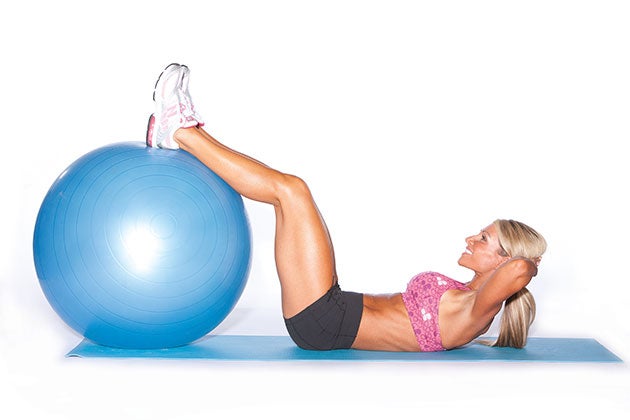
Target Muscles: rectus abdominis (upper portion)
Set Up: Lie faceup on a mat with your head, shoulders and torso on the floor and your heels and calves resting on top of a stability ball. Place your hands behind your head, elbows flaring out to the sides.
Action: Contract your abdominals as you curl your torso upward, lifting your head and shoulders from the ground but keeping your lower back on the floor. Slowly lower yourself back down and repeat.
Tip: Imagine bringing the bottom of your rib cage toward the top of your hips. Also, don’t tug on your neck as you curl up.
Expert Analysis: Having your legs on the ball helps activate your abs because unlike a stable bench, the ball “pushes” back at you, says expert Jonathan Ross.
Stability Ball Roll-Up (not shown)
Target Muscles: rectus abdominis (lower portion), internal and external obliques, transverse abdominis, latissimus dorsi
Set Up: Get into a straight-leg push-up position with your hands under your shoulders on the floor and your feet on a stability ball, soles facing the ceiling. Contract your back to draw your shoulder blades toward each other.
Action: Tighten your abs as you bend your legs to roll the ball toward your body, pointing your tailbone to the ceiling at the top of the move. Slowly straighten your legs to roll the ball away from you, back to the starting position. Repeat.
Tip: Keep your back straight throughout the move and always have a slight bend in your elbows.
Expert Analysis: This exercise requires mobility and stability, says Ross – a combination that, when done properly, is the essence of an effective abs movement.
Russian Twist On Ball
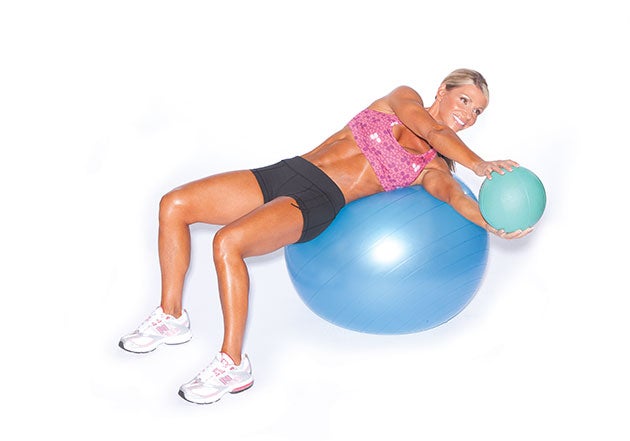
Target Muscles: internal and external obliques
Set Up: Holding a medicine ball in both hands, sit on a ball with your feet flat on the floor, shoulder-width apart. Extend your arms in front of you so that your hands are at about shoulder height. Walk your feet forward and lean back until your upper back and shoulders rest on the ball.
Action: With your arms extended, rotate your torso to your right until your shoulder touches the stability ball. Return to the center, then rotate your torso to the left, directing your outstretched arms at the same time. Return to the center and continue, alternating sides.
Tip: Be sure that you rotate from your abs, not your shoulder joints, as you twist from side to side.
Expert Analysis: Take Ross’s advice: To make this move harder, ditch the medicine ball. Gravity makes this exercise easier because it pulls the ball as you rotate.
Ball Plank
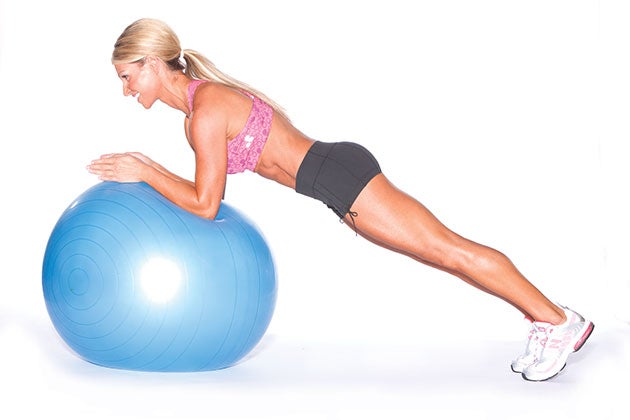
Target Muscles: transverse abdominis, erector spinae, pectoralis major, deltoids, scapular retractors
Set Up: Bend your knees and kneel on the floor in front of a ball, resting your forearms on top. Keep your abs tight and your back straight.
Action: Lift your knees from the floor, balancing between your forearms and toes. Hold, continuing to breathe normally throughout.
Tip: Rubber necking doesn’t belong in this move. Keep your spine neutral by looking at a spot in front of the ball.
Expert Analysis: Ross notes that a plank on a ball shifts some of your body weight toward your feet, but the lowered resistance around your core is more than made up for by the stability challenge.
Advance Your Six-Pack Plan
Core ready for a challenge? Score your six-pack goal by tackling these tough moves.
Stability Ball Crunch
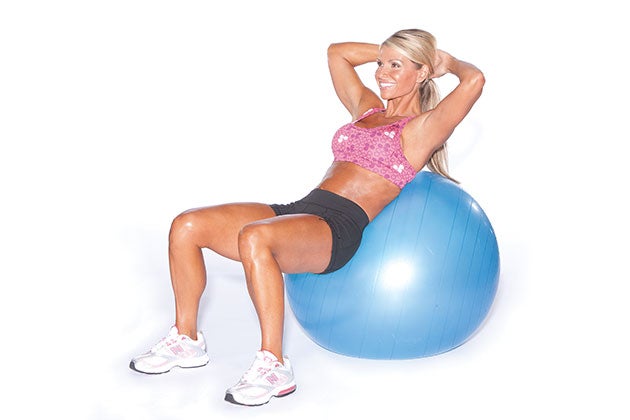
Target Muscles: rectus abdominis (upper portion), internal and external obliques, transverse abdominis
Set Up: Sit on a ball with your legs bent, feet flat on the floor. Walk your feet away from the ball and lean backward until the ball is under your mid to upper back with your shoulders and head just off of the ball’s surface. Place your hands lightly behind your head, elbows facing out to the sides.
Action: Keeping your abdominals tight, slowly curl your torso upward, lifting just your upper back from the ball. Slowly return to the starting position and repeat.
Tip: work your stabilizing muscles by bringing your feet close together.
Expert Analysis: Your muscles work harder when you do a crunch on the ball, not just your rectus abdominis (a.k.a. your six-pack), according to expert Jonathan Ross. Emphasize lifting your torso lightly instead of jerking upward.
Stability Ball Pike
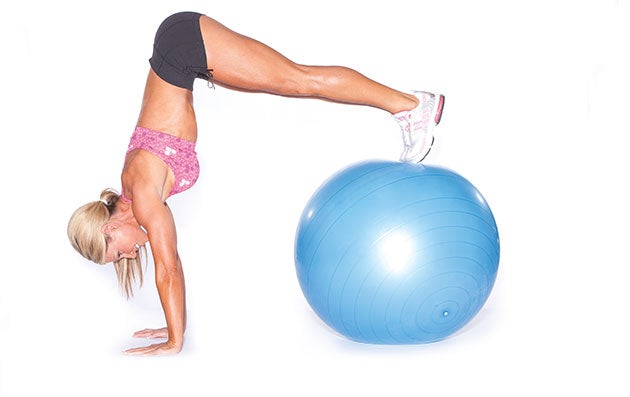
Target Muscles: rectus abdominis (lower portion), internal and external obliques, transverse abdominis, latissimus dorsi
Set Up: Get into a straight-leg push-up position with your hands on the floor under your shoulders and your feet on a stability ball, soles facing the ceiling. Retract your shoulder blades.
Action: Contract your abs up as you flex your hips, rolling the ball toward your body as you direct your tailbone toward the ceiling. Your body should form an inverted V with your toes up on the ball and your torso in a straight line. Slowly lower your hips to return to the start. Repeat.
Tip: Don’t round your back as you roll the ball.
Expert Analysis: The stability ball pike requires both abdominal strength and stability to pull your abs in and your torso up against gravity, says Ross. Your rectus abdominis works especially hard as it pulls on the hips.
Obliques Rotation
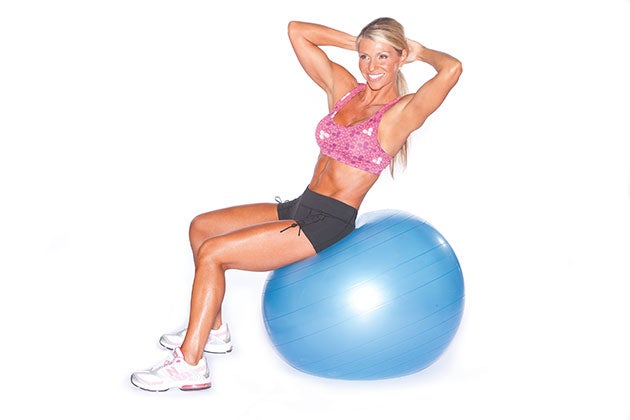
Target Muscles: internal and external obliques, rectus abdominis, transverse abdominis
Set Up: Sit on a ball with your feet on the floor positioned shoulder-width apart. Brace your abs and slowly walk your feet forward until your torso is about 45 degrees to the floor. Place your hands lightly behind your head without pulling it forward, elbows pointing out to the sides.
Action: Slowly twist your torso to the left, then the right, contracting your abdominals throughout the move and maintaining a controlled speed. Repeat, alternating between the left and right sides.
Tip: don’t let your elbows fold in front of your body.
Expert Analysis: How does this move work your middle? Ross says that the backward lean engages your transverse abdominis and rectus abdominis to hold your body in place while your obliques control the twisting motion.
Stability Ball Roll-Out
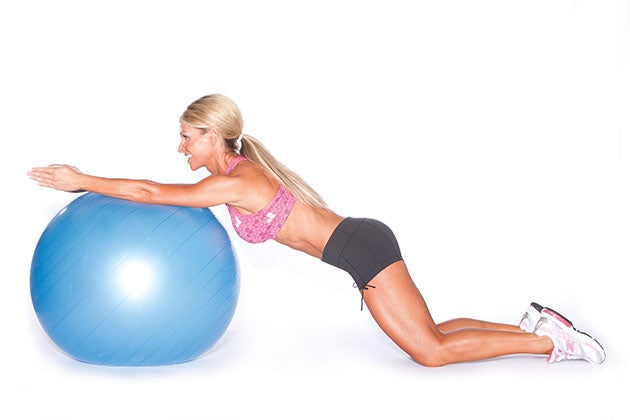
Target Muscles: transverse abdominis, internal and external obliques, latissimus dorsi, deltoids, triceps brachii
Set Up: Kneel in front of a ball, keeping your back straight. Bend your arms to 90 degrees and rest your forearms on the ball.
Action: Contract your abs and lean forward while extending your arms, keeping your torso straight as you roll the ball away from you. Stop when your arms are almost straight and your body is nearly aligned from your shoulders to your hips to your knees; you should be balancing on the ball with your forearms and elbows. Return to the start and repeat.
Tip: Remember that rolling the ball too far can put pressure on your shoulder joints.
Expert Analysis: Rolling shifts your center of gravity, says Ross, changing the intensity within each rep. The move gets harder as you roll forward and less intense as you roll. back.